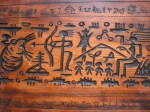Largest archery tournament
On 4 August 2010, the new Guinness World Records™ accomplishment for the largest archery tournament was set in Balaga’ergaole Town, Xiwuzhumuqin County, Inner Mongolia, China. 1,024 archers took part in the tournament, breaking the previous record of 332.
The competition was organized by the People’s Government of Xiwuzhuuqin County. The participants were from Xiwuzhumuqin county and nearby regions. The opening ceremony of the archery tournament was held on 3 August 2010. At the opening ceremony, the archers gave an archery demonstration after which the competition started. During the 2-day competition, 1,024 participants took part.
As the attempt adhered to the guidelines of Guinness World Records™, Adjudicator Angela Wu announced the attempt a success and presented the official certificate to the organizer.
This is the third Guinness World Record™ record set by Xiwuzhumuqin County. The record for the largest Mongolian wrestling tournament and most runners in a horse race were set in the same place in 2004 and 2005 respectively.
By Angela Wu








You must be logged in to post a comment.